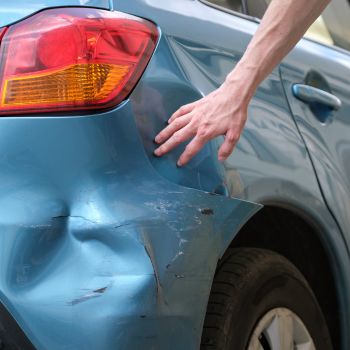 Whether you were rear-ended by another driver or backed into a pole, chances are your bumper saw some scrapes and a dent or two. Unfortunately, bumper damage isn’t always superficial and can mean this component doesn’t protect your vehicle as well as it should. Before you drive off and avoid maintenance, learn about different types of bumper damage.
Whether you were rear-ended by another driver or backed into a pole, chances are your bumper saw some scrapes and a dent or two. Unfortunately, bumper damage isn’t always superficial and can mean this component doesn’t protect your vehicle as well as it should. Before you drive off and avoid maintenance, learn about different types of bumper damage.
How Your Bumper Functions
The bumpers on your car act as a protective mechanism for the hood, grill, trunk and cooling system, deflecting and absorbing impact during a crash. While the bumper looks like a plastic or metal covering, it helps lessen damage to key parts of your vehicle during a minor collision or fender-bender.
In the past, bumpers simply resembled a curved piece of metal added to the front and back of your car. Today, they are:
- Constructed of aluminum, steel or plastic.
- Further equipped with a reinforced bar or compressible foam underneath.
- Tested to absorb and lessen damage from impacts up to five miles per hour by a vehicle of a similar size and weight. At this speed, no damage should occur to your car’s frame and all occupants should remain safe.
Especially since bumpers have gotten lighter in recent years, impacts above this threshold may dent your car or worse, affect the fuel, exhaust or cooling system. Similarly, driving without a bumper puts all related components, the engine and headlights at risk of more damage.
Types of Bumper Damage
Bumper damage can range from superficial to structurally compromising. Understanding the severity of the damage is crucial to ensuring your vehicle remains safe and functional.
Scratches and Scrapes
This type of bumper damage stems from having another driver lightly back into your car, accidentally scraping against another car, having a grocery cart roll into your vehicle or driving over a curb. In these cases, your bumper will need to be repainted to reduce risk of rust damage, which can compromise how well it protects your vehicle.
Dents
If you back into a pole or another car rear-ends you, the bumper may be left with a noticeable dent. This is relatively common for fender-benders and may be accompanied by scratches or scrapes that expose the metal beneath.
However, the bumper won’t protect your vehicle as effectively from this point on, unless you get it repaired. Paintless dent repair, which massages the dents out from the inside, can help restore the bumper. Ignoring the issue may contribute to cracks, eventually requiring replacement to fully protect your vehicle.
Punctures, Cracks and Tears
Backing into an object or surface with a sharp or pointed edge has potential to puncture, crack or tear into the bumper. Although you might dismiss this as cosmetic, a puncture can also lead to cracking and compromise how well the bumper protects your vehicle. Based on the degree of damage, the area can be filled in with a polymer compound or the full part may need to be replaced.
It's important to address any damage as soon as possible. Even small issues can escalate over time, leading to more expensive repairs down the road. If your bumper recently experienced damage—whether it's a dent, tear, puncture, or cracking—it's best to bring your vehicle to a trusted auto body shop for a diagnostic assessment and repairs. You can also request mobile bumper repair services to have professionals come to you. Don't ignore the signs—your safety and the longevity of your vehicle depend on it. Contact us today to schedule your appointment!
Ningbo Senmiao Trading Co., Ltd. , https://www.nbsenmiao.com